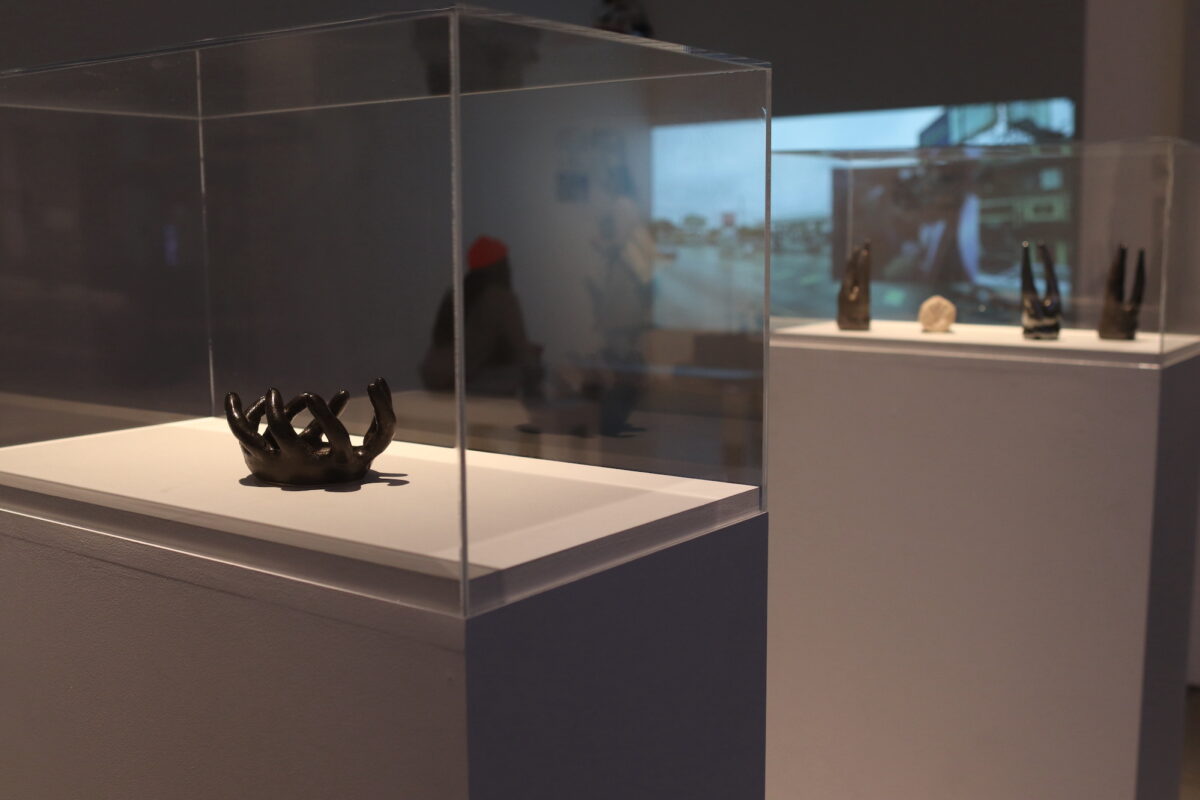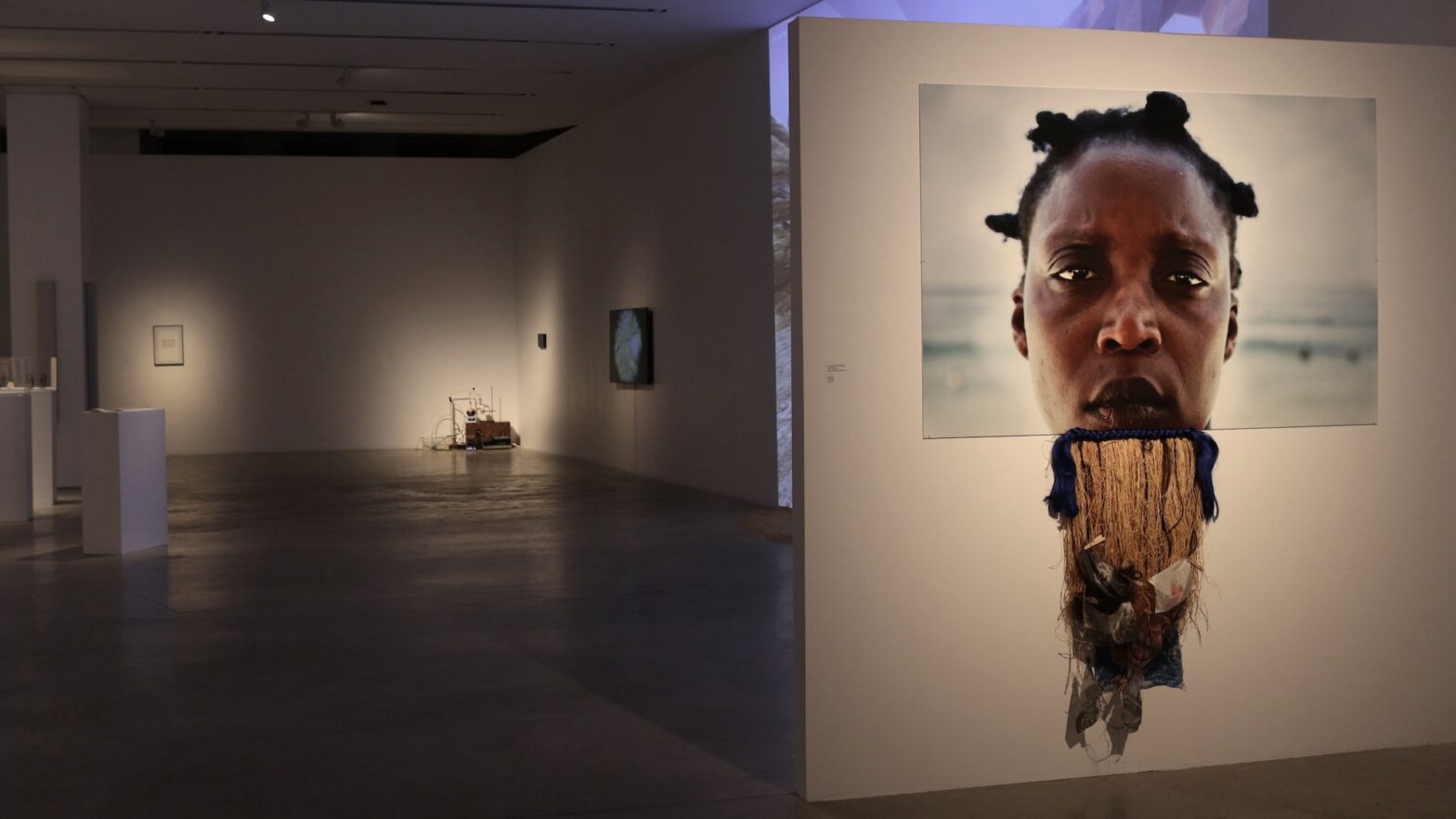An art exhibition celebrates beauty and wickedness in Black realities.
There are representations in artistic practice, often more times than not reincarnations of past stereotypes, and then there is reality.
“_assembly, alchemy, ascension [a^3],” an exhibition curated by JAZALYN, Shameekia Shantel Johnson and Yvonne Mpwo, plants this reality against the white walls of the Anna-Maria and Stephen Kellen Gallery at 66 Fifth Ave.
“It is an attempt to map and puncture points of pressure thus subverting and unraveling a false, destructive reality. To escape and transmit outside and beyond the white racist imaginary,” the exhibition description reads.
The group exhibition of thirteen artists, on view through Friday, critically analyzes Black, brown and queer modernity through artists’ different mediums. Take for instance, Xavier Scott Marshall’s and Willy Ndataria’s video installation “Genesis,” a reinterpretation of the Bible’s Genesis scripture. Woven into the installation are images of the moments leading up to George Floyd’s death, Nenobia Washington (better known as BkTidalWave) hanging out in Union Square with rapper A$AP Rocky, and video of Martin Luther King Jr. delivering his “I Have a Dream” speech. It’s a subversive nod to rummaging through distorted history — layered with meaning, as Washington died last November — but finding faith, however one might, through spirituality, music and community.
The exhibition initially grew out of a proposal by educator Neta Bomani and JAZSALYN, Parsons School of Design professor of design and technology. After several COVID-19-related delays caused “_assembly, alchemy, ascension [a^3]” to be pushed back by two years — during which Bomani left the project — the exhibition opened on Feb. 17 at the Parsons gallery.
Since 2020, when The New School moved to remote learning in response to the pandemic, JAZALYN has expanded the initial a^3 exhibition proposal into a femme-led research collective called black beyond. Not only did she see the exhibition as an opportunity to reallocate resources to people within the art industry besides artists, but she also used it to increase visibility of emerging artists.
“By having access to resources at The New School, I’m trying to make those [artists] more accessible to people that are either within this community or outside of The New School community,” JAZALYN said in an interview with The New School Free Press.
Over the past two years, JAZALYN completed her masters at Parsons and returned to teach a course entitled alt (reality). In the wake of lockdown restrictions, she also built a network of prison abolition writing workshops and a monthly radio show, “alternative realities,” devoted to uplifting Afro-American voices. A recent example is an episode dedicated to Jason Walker, a father killed by a Fayetteville off-duty officer.
Featuring artists across the African diaspora, “_assembly, alchemy, ascension [a^3]” is black beyond’s first public showing.
“[The exhibition envisions] a solution where we could transcend these various tragedies within the Black and brown community, and have a space to reimagine teachings to exist within,” co-curator Shantel Johnson said in an interview with the Free Press.
Near Marshall’s and Ndataria’s installation, “Wish Bones 1-4,” a piece featuring the teeth of Jourdon Anderson, a formerly enslaved African-American, reimagines historian Robin D.G. Kelley’s description of Jourdon wanting to be free post-Civil War. Interdisciplinary artist Anastasia Warren uses silver ceramics as a way of analyzing Anderson’s 1865 letter to Colonel P.H., in which he demanded wages owed for his 32 years of labor.
“There’s a lot of beauty, a lot of wickedness, in this history that we have,” Warren told the Free Press.

Beauty and wickedness capture one of “_assembly, alchemy, ascension [a^3]’s” most notable installations. Brooklyn-based performance artist Asia Stewart’s two-channel installation, “No More Blue Mondays,” juxtaposes the artist’s nude body, draped in nylon stockings and attached to an ironing board, with 20th-century archival black and white film of a variety of white women. One is a sex educator; another a classic housewife; others are seamstresses. While we see and hear the daily lives of these women, Stewart carefully wraps her body in the stockings, symbolizing the silencing and marginalization of women of color’s voices throughout history.
The same can be said for photographer and visual artist Adama Delphine Fawundu’s photograph “Deep Inside I’m Blue No. 2.” The artist is pictured clear-eyed with a defiant gaze. In different exhibitions, the gaze had been covered with ultralight eyes, but for “_assembly, alchemy, ascension [a^3],” the eyes are full of life under the beauty and wickedness of Black reality, clear in its future.
It’s a gaze that pedestrians see piercing through Kellen Gallery. It’s a gaze that dominates West 13th Street’s casual blasé restaurants and pilates classes. It’s a glare that is loudly felt, but, inside Kellen’s Gallery, is lost in translation due to the lack of the usual accompaniment of a multi-media video.
But maybe, just maybe, that’s what JAZALYN wants for “_assembly, alchemy, ascension [a^3]” and black beyond: A world where the audience sits and emotionally attaches themselves to Black realities instead of always rehashing Black trauma.
“black beyond wouldn’t have the support of being where it’s at, in our very young age, without black leadership within these spaces,” JAZSALYN said of the group’s progress within burgeoning art galleries and institutional spaces over the past two years. “It seems to be a good sign, and time will tell.”







